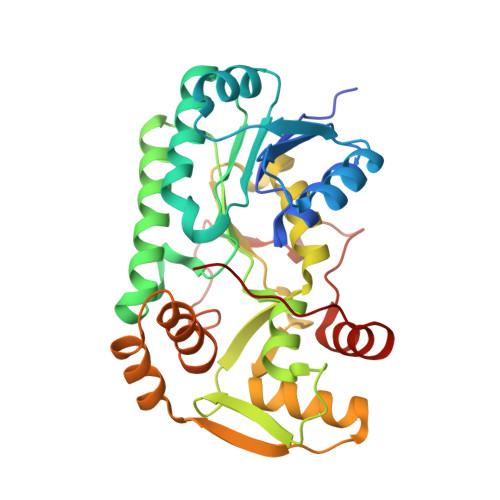The multiple phenylpropene synthases in both Clarkia breweri and Petunia hybrida represent two distinct protein lineages.
Koeduka, T., Louie, G.V., Orlova, I., Kish, C.M., Ibdah, M., Wilkerson, C.G., Bowman, M.E., Baiga, T.J., Noel, J.P., Dudareva, N., Pichersky, E.(2008) Plant J 54: 362-374
- PubMed: 18208524
- DOI: https://doi.org/10.1111/j.1365-313X.2008.03412.x
- Primary Citation of Related Structures:
3C1O, 3C3X - PubMed Abstract:
Many plants synthesize the volatile phenylpropene compounds eugenol and isoeugenol to serve in defense against herbivores and pathogens and to attract pollinators. Clarkia breweri flowers emit a mixture of eugenol and isoeugenol, while Petunia hybrida flowers emit mostly isoeugenol with small amounts of eugenol. We recently reported the identification of a petunia enzyme, isoeugenol synthase 1 (PhIGS1) that catalyzes the formation of isoeugenol, and an Ocimum basilicum (basil) enzyme, eugenol synthase 1 (ObEGS1), that produces eugenol. ObEGS1 and PhIGS1 both utilize coniferyl acetate, are 52% sequence identical, and belong to a family of NADPH-dependent reductases involved in secondary metabolism. Here we show that C. breweri flowers have two closely related proteins (96% identity), CbIGS1 and CbEGS1, that are similar to ObEGS1 (58% and 59% identity, respectively) and catalyze the formation of isoeugenol and eugenol, respectively. In vitro mutagenesis experiments demonstrate that substitution of only a single residue can substantially affect the product specificity of these enzymes. A third C. breweri enzyme identified, CbEGS2, also catalyzes the formation of eugenol from coniferyl acetate and is only 46% identical to CbIGS1 and CbEGS1 but more similar (>70%) to other types of reductases. We also found that petunia flowers contain an enzyme, PhEGS1, that is highly similar to CbEGS2 (82% identity) and that converts coniferyl acetate to eugenol. Our results indicate that plant enzymes with EGS and IGS activities have arisen multiple times and in different protein lineages.
Organizational Affiliation:
Department of Molecular, Cellular and Developmental Biology, University of Michigan, 830 North University Street, Ann Arbor, MI 48109-1048, USA.















